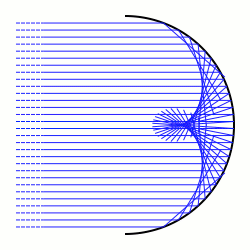Caustic (mathematics)

In differential geometry and geometric optics, a caustic is the envelope of rays either reflected or refracted by a manifold. It is related to the concept of caustics in optics. The ray's source may be a point (called the radiant) or parallel rays from a point at infinity, in which case a direction vector of the rays must be specified.
More generally, especially as applied to symplectic geometry and singularity theory, a caustic is the critical value set of a Lagrangian mapping (π ○ i) : L ↪ M ↠ B; where i : L ↪ M is a Lagrangian immersion of a Lagrangian submanifold L into a symplectic manifold M, and π : M ↠ B is a Lagrangian fibration of the symplectic manifold M. The caustic is a subset of the Lagrangian fibration's base space B.[1]
Catacaustic
A catacaustic is the reflective case.
With a radiant, it is the evolute of the orthotomic of the radiant.
The planar, parallel-source-rays case: suppose the direction vector is and the mirror curve is parametrised as . The normal vector at a point is ; the reflection of the direction vector is (normal needs special normalization)
Having components of found reflected vector treat it as a tangent
Using the simplest envelope form
which may be unaesthetic, but gives a linear system in and so it is elementary to obtain a parametrisation of the catacaustic. Cramer's rule would serve.
Example
Let the direction vector be (0,1) and the mirror be Then
and has solution ; i.e., light entering a parabolic mirror parallel to its axis is reflected through the focus.
References
- ↑ Arnold, V. I.; Varchenko, A. N.; Gusein-Zade, S. M. (1985). The Classification of Critical Points, Caustics and Wave Fronts: Singularities of Differentiable Maps, Vol 1. Birkhäuser. ISBN 0-8176-3187-9.